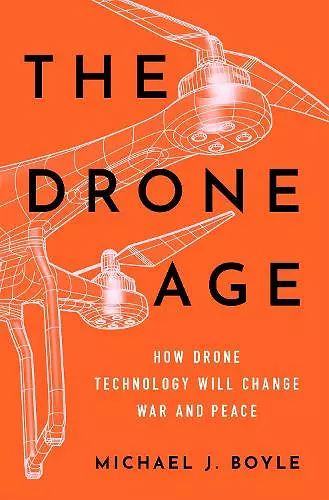The Drone Age
How Drone Technology Will Change War and Peace
Format:Hardback
Publisher:Oxford University Press Inc
Published:10th Sep '20
Should be back in stock very soon

Over the last decade, the rapid pace of innovation with drone technology has led to dozens of new and innovative commercial and scientific applications, from Amazon drone deliveries to the patrolling of national parks with drones. But what is less understood is how the spread of unmanned technology will change the patterns of war and peace in the future. Will the use of drones produce a more stable world or will it lead to more conflict? Will drones gradually replace humans on the battlefield or will they empower soldiers to act more precisely, and humanely, in crisis situations? How will drones change surveillance around the world and at home? In The Drone Age, Michael J. Boyle examines how unmanned technology alters the decision-making and risk calculus of its users both on and off the battlefield. It shows that the introduction of drones changes the dynamics of wars, humanitarian crises and peacekeeping missions, empowering some actors while making others more vulnerable to surveillance and even attack. The spread of drones is also reordering geopolitical fault lines and providing new ways for states to test the nerves and strategic commitments of their rivals. Drones are also allowing terrorist groups like the Islamic State to take to the skies and to level the playing field against their enemies. Across the world, the low financial cost of drones and the reduced risks faced by pilots is making drone technology an essential tool for militaries, peacekeeping forces and even private companies. From large surveillance drones to insect-like micro-drones, unmanned technology is revolutionizing the way that states and non-state actors compete with each other and is providing game-changing benefits to those who can most rapidly adapt unmanned technology to their own purposes. An essential guide to a potentially disruptive force in modern world politics, The Drone Age shows how the mastery of drone technology will become central to the ways that governments and non-state actors seek power and influence in the coming decades.
These vignettes are neat little observations that remind us that, despite all the technology, this is also a story about people, both heroes and villains...Delicately balanced additions to the text that neither detract nor distract from the core themes of the book are little touches that make this book pleasing to read. * Philip Wane, Nottingham Trent University, Prometheus *
A concise and comprehensive overview of the world the drone made. * New Scientist (Books of the Year) *
A seminal work of impressively thoughtful and thought-provoking scholarship, The Drone Age: How Drone Technology Will Change War and Peace is an extraordinary, timely, and unreservedly recommended addition to both community and college/university library drone technology collections and supplemental curriculum studies. It should be noted for the personal reading lists of students, academia, governmental policy makers, and non-specialist general readers with an interest in the subject. * Michael Dunford, Midwest Book Review *
A must read...The book is just as valuable on surveillance, the rise of information warfare and the way that the best intentions can turn the world we knew on its head. But, ultimately, if you read only one book about drones, this should be it. * Simon Ing, New Scientist *
A highly informative treatment of the current role and future potential of drones. * Kirkus, Starred Review *
What Boyle offers in the place of righteous condemnation is a quiet moral clarity. When writing about armed drones like the Reaper and Predator, he is careful to take note of the horror of continuously fearing death from above. When describing the work of commanding the drones, his sympathies clearly lie with the pilots, a third of whom experience burnout and more than a sixth of whom contend with clinical mental distress. * Eoin O'Carroll, Christian Science Monitor *
ISBN: 9780190635862
Dimensions: 163mm x 234mm x 36mm
Weight: 703g
400 pages